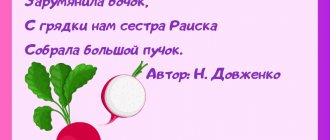Class hour with a presentation on the topic “Proper nutrition is the key to good health,” 7th grade
Class hour on the topic of healthy lifestyle in 7th grade.
Development Goal: creating favorable conditions for the formation of a careful attitude towards their own health among 7th grade students by observing a proper diet. Objectives: 1. teach 7th grade students to adhere to a healthy lifestyle; 2. contribute to the development of the ability of 7th grade students to make healthy food choices; 3. teach 7th grade students to differentiate food products into harmful and healthy; 4. develop critical thinking of 7th grade students. Form of the class hour: conversation Duration of the class hour: 45 minutes Participants of the class hour: 7th grade students, 7th grade class teacher Interdisciplinary connections: medicine, biology, ecology Technologies: health-saving technology, ICT Preparatory work: selection of literature on the topic of the class hour, preparation classroom for the class hour, development of assignments for 7th grade students, preparation of handouts, selection of pictures on the topic of the class hour. Material support: sheets of paper, felt-tip pens, ballpoint pens, bags with working material, tables with the names of harmful food additives (20 pieces), an audio recording with the song “About a Healthy Lifestyle” performed by the musical group “Etalon”, food packaging, 3 “Seven-flowered flower” large format, cut out of paper, portrait of A.P. Chekhov, portrait of Socrates. Equipment: computer, speakers, screen, projector. (epigraphs are written on the board)
| We do not live to eat, but we eat to live. (Socrates) When you get up from the table hungry, you are full; if you get up after having eaten, you have overeaten; If you get up after overeating, you are poisoned. (Anton Pavlovich Chekhov) |
Progress of the class hour
(7th grade students are divided into four groups and sit at different tables).
1. Organizational moment.
Class teacher: Hello, guys! Today our class hour will be devoted to a very important topic. Please look at the screen. (Pictures on the topic “Healthy Eating” are projected onto the screen.)
2. Setting the goal of the class hour.
Motivation for learning activities. Class teacher: What do you think all these pictures have in common?
What are we going to talk about today? (7th grade students answer that the class will talk about healthy eating, the role it plays in a person’s life, and what needs to be done in order to eat healthy). 3. Conversation about proper nutrition.
Class teacher: Well done! Let's look at the board. I will read for you the statements of famous personalities. (The class teacher reads statements of famous personalities that are written on the board). Class teacher: Guys, what do you think Socrates meant when he said that “we do not live in order to eat, but we eat in order to live”? (Students answer). Class teacher: In fact, you shouldn’t make a cult out of food. Then please tell me what functions does food perform? (Students answer that food contains various vitamins and minerals that are necessary for the human body; food supplies the human body with energy, etc.). Class teacher: That's right! Well done! Let's pay attention to the words of the classic of world literature, writer, doctor by training, Anton Pavlovich Chekhov, who once said: “When you get up from the table hungry, you are full; if you get up after having eaten, you have overeaten; if you get up after overeating, you are poisoned.” What do you think the writer meant? (The class teacher shows the students a portrait of A.P. Chekhov. The students respond.) A.P. Chekhov Class teacher: Indeed, A.P. Chekhov advocated adherence to a diet and also against overeating. Why do you think overeating is bad for all of us? (Students answer). Class teacher: But not only overeating can harm our health. Fasting can also cause harm. Why do you think? (Students answer). Class teacher: If a person eats right, it will help him maintain his precious health. In your opinion, what does it mean to be healthy? (Students answer that “being healthy” means not getting sick, experiencing positive emotions, eating right, etc.). Class teacher: That's right! Do you think our emotional state depends on nutrition? (Students express their own points of view). Class teacher: Thank you for your answers. In fact, scientists have proven that if a person eats a piece of real chocolate a day, then he will begin to produce happiness hormones - endorphins. (A picture of chocolate is projected onto the screen.) Chocolate
Class teacher: This means that in this case the person will be less susceptible to various kinds of stress and will experience positive emotions. But do not forget that in everything you need to observe moderation. What do you guys think, what food products can also lift our mood? (Students express their own points of view). Class teacher: The list of such products, according to scientists, includes bananas, apples, beets, strawberries, and blueberries. (A picture of blueberries is projected onto the screen.) Blueberry
Class teacher: I think that these products will also be important sources of vitamins and minerals for the human body. What vitamins do you know? (Students answer). Class teacher: Great! For example, iodine is found in sea fish, vitamin A - in milk, carrots, spinach, B vitamins - in cottage cheese, eggs, oatmeal, vitamin C - in citrus fruits, vitamin D - in vegetable oil, beef. Please look at the table and you will see that the list of products that include various vitamins is very rich. (A table with images of food products is projected onto the screen.)
Class teacher: What can happen to a person who receives insufficient vitamins and minerals? (Students answer). Class teacher: In this case, the person may get sick. Therefore, a balanced diet is important for all of us. Guys, what is a “balanced diet”? (Students answer). Class teacher: Correct!
In addition to vitamins and minerals, food should include sufficient amounts of proteins, fats and carbohydrates. 4.Organization of work in groups.
Class teacher: A balanced diet is considered to be a daily diet that fully meets the body’s daily energy needs, as well as maintaining an optimal balance of vitamins and microelements. And now, guys, I bring to your attention a task called “Flower—Seven Flowers,” which you will complete in groups. Each of your groups has a large flower cut out of paper on their tables, which has 7 petals of different colors. The first half of the proverb is written on each petal, and you need to complete the second half of the proverb on the petals yourself, using the hints written on small pieces of paper. You have 5 minutes to complete this task. (Students complete the task in groups). Task No. 1: Brainstorming in the form of the game “Flower of Seven Flowers.” Seven-flowered flower
The first halves of the proverbs are written on the flower petals, the second halves of the proverbs are written on sheets of paper with hints).
• Everyone needs (both lunch and dinner). • What is food and drink, (such is living). • Health is close: (look for it in the bowl). • The more you chew, (the longer you will live). • After lunch, lie down (after dinner, walk around). • When I eat, (I am deaf and dumb). • What kind of food, (such and walking). Class teacher: The time to complete this task has expired. Let's see what you got. (The class teacher checks the correct completion of the task by groups of students). Task No. 2: Choose one of the proverbs and explain how you understand its meaning. Class teacher: And now each group must choose one of the proverbs and explain what it is about. You have 3 minutes to complete this task. (Students complete the task in groups). Class teacher: So, let's see what proverbs you have chosen. (Students give a comment on the proverb that was chosen in their groups). Class teacher: Well done! Guys, I think you noticed that people thought about proper nutrition in ancient times, because proverbs can rightfully be considered folk wisdom. The inhabitants of Ancient Greece, for example, rarely got sick and lived a long time! Why do you think the Greeks were so lucky? (Students express their own points of view). Class teacher: Indeed, the Greeks ate plant foods, ate little meat, and they also did not know what tobacco was, they moved a lot. While at school they could study science for half a day. By the way, the famous philosopher Socrates was also a Greek. (The class teacher shows a portrait of Socrates). Socrates
Class teacher: He lived for almost 70 years. In ancient times, many people often did not live to be forty years old, so we can assume that Socrates lived quite a long time. So what is the secret of longevity!? (Students answer). Class teacher: Guys, how do you understand the meaning of the proverb - “A mill lives on water, but a man lives on food”? (Students answer). Class teacher: Why does a person need food? (Students answer). Class teacher: Even at rest, a person spends energy. Therefore, humans need nutrients for the normal functioning of organ systems and the entire body as a whole. It is extremely important for children to eat properly because they need to grow and develop. School age is a very important period of life, when complex restructuring of the body and metabolism takes place. The process of learning at school significantly increases the physical and emotional stress on the child’s body, which has to spend a large amount of energy. It is worth remembering that the only source of energy for humans is food. Therefore, his health largely depends on how a person eats and whether he follows a diet. What conclusion can we draw in this case? (Students answer that food is needed to maintain the vital functions of the human body. The class teacher writes the conclusion on the board). Class teacher: Guys, I think each of us loves to eat. What should the food be like? (Students answer that food should be tasty and varied. The class teacher writes the second conclusion on the board). Class teacher: Great! We have already made two conclusions that may be principles of healthy eating. Now I’ll read a poem for you, and you try to find the principles of healthy eating mentioned in it. Moderation, of course, is also needed in food, so as not to encounter unexpected misfortune, it is necessary to eat at a strictly appointed hour, a little bit and several times a day.
Always follow this rule, then your food will be healthy. Regime is also important in nutrition. Then we will escape from illnesses. You also need to know about calorie consumption so that you don’t overdo it in a day! Children need lollipops, sweets, buns, cakes in small quantities. (Students answer that nutrition should be moderate and regular. The class teacher writes this conclusion on the board).
Class teacher: Do you think all food products are equally healthy? (Students answer).
5. Practical part.
Class teacher: For our class hour, each of you had to bring packaging for some food products. Please look carefully at the packages you brought. Each of them must have a label with the name of the food product, as well as information about it. It is not uncommon to find long lists of food additives on such labels, especially on sweets, soft drinks, confectionery products, etc. Do you know anything about nutritional supplements? What are they? Why can you find the letter “E” in their name? (Students express their own points of view). Class teacher: Currently, food production can hardly do without food additives. After all, they are used to preserve food products for a long time, improve their color, and enhance their taste. The European Union adopted a system for codifying food additives: each of them was designated by the letter “E”, as well as a number. According to this system, dyes (from E-100 to E-199) can be added, for example, to confectionery products and margarine. Food additives (E-200 to E-299) help increase the shelf life of the product. Antioxidants (E-300 to E-399) can protect food products from oxidation; they are added to chewing gum and sweets. Stabilizers (E-400 to E-490) can maintain food products in a jelly-like consistency. Emulsifiers (from E-500 to E-599) can be used in the process of preparing water-fat mixtures, for example, mayonnaise. It also cannot do without flavor enhancers and flavorings (from E-600 to E-699), which are added to sauces and sausages. Among food additives there may be particularly harmful additives, a list of which you can find in the tables that lie on your tables. (The class teacher shows the students a table of harmful food additives).
Class teacher: Few people know that a large number of such additives are not permitted for use in the food industry of the Russian Federation, and some of them are completely prohibited for use in food products produced in our country. Unfortunately, safety testing of food additives is not carried out consistently in all countries. Therefore, it is important to know which food additives are especially harmful. It is not recommended to buy food products whose packaging does not indicate the composition. Guys, have you often seen food packaging on which a large number of nutritional supplements with the letter E were written? (Students answer). Class teacher: Nowadays, we can often see on labels that the food product contains transgenic, genetically modified products, which have the abbreviation GMP. Have you heard anything about them? (Students answer). Class teacher: What is GMO? (Students answer). Class teacher: Genetically modified organisms (GMOs) are organisms (i.e. plants, animals or microorganisms) whose genetic material (DNA) has been altered in ways that would not be possible in nature as a result of reproduction or natural recombination. Foods produced from or using GM organisms are often called GM foods or GMFs. Do you think genetically modified foods are harmful to humans? (Students express their own points of view). Class teacher: Thank you for your answers! In fact, GMO foods currently entering the international market have undergone safety assessments and are unlikely to pose a threat to human health. In addition, no human health effects have been detected as a result of consumption of such foods by the general population in countries where they are approved. But scientists still claim that such products can cause allergies in humans. Scientists have also proven that the more territories occupied by GM crops, the smaller the number of insects becomes, and because of this, the populations of some animals may also decline. This situation contributes to the emergence of ecological imbalance. Class teacher: Now I am holding a package of instant coffee in my hands. The composition of this product is written on the back of the package. We see that it contains the following food additives: E-471, E-481, E-551, E-340ii, E-452i. I looked in the table of harmful food additives and found one of them - E-340, which can cause stomach upset. Now you will work in groups. You also need to determine whether the food products (packaging for which you brought to class) contain dangerous food additives. Please write down the names of harmful food additives that you come across. Use the tables to complete this task. Analyze what diseases they can cause in humans. You have 5 minutes to complete this task. (Students complete the task in groups).
Class teacher: Let's see what dangerous food additives you came across. (Students answer). Class teacher: So, we found quite a lot of dangerous food additives in the food we eat.
What conclusions can we draw? (Students answer). 6. Reflection stage.
Class teacher: Unfortunately, we are unlikely to be able to completely eliminate all food products from the diet that contain dangerous food additives, but we can limit their use. Let's all think together what nutritional rules need to be followed in order to be healthy? (Students name the nutrition rules. The class teacher writes them on the board). Rules for healthy eating: 1. You can’t overeat!
2. You need to eat food at the same time, which is simple and freshly prepared! 3. While eating, you need to chew your food thoroughly! 4.You should always wash your hands before eating! 5. You must avoid eating foods whose composition is unknown or questionable! 6. Before consuming a food product, you need to make sure that its expiration date has not expired! (The song “About a Healthy Lifestyle” is performed by the musical group “Etalon”).
Class teacher: Guys, now I will ask those who choose a healthy lifestyle and are ready to eat right and follow a diet to raise their hands.
(Students raise their hands.) 7. The final stage of the class hour.
Class teacher: Guys, our class hour has come to an end! I wish you good health! Don't forget to strengthen your body and spirit! List of used literature: 1. Solovyov G.M.
Fundamentals of a healthy lifestyle and methods of health-improving physical culture: Textbook. Parts 1 and 2. - Stavropol: SSU Publishing House, 2007. Presentation on the topic: Proper nutrition is the key to good health
We recommend watching:
Class hour: Friendly class, grades 5-7 Extra-curricular event on the topic: Healthy lifestyle, grades 7-8 Class hour “We are the masters of our Motherland” with a presentation, grades 6-8 Class hour about the work of Pogudina for grades 7-8
Similar articles:
Class hour in 8th grade on the topic: Healthy lifestyle
Class hour “Self-presentation of your hobbies”, 7th grade
Class hour “Family Hearth”, 7th grade
Class hour “My Moscow”, 7th grade
Class hour “Why do people need dictionaries and encyclopedias”, 7th grade





